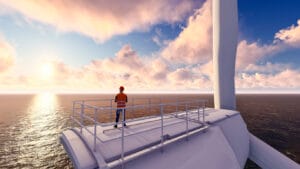In December, Louisiana’s Department of Natural Resources approved the state’s first offshore wind farm development projects.
The two approved projects, which may begin construction as early as this year, will be spearheaded by Diamond Offshore Wind (a subsidiary of Mitsubishi) and Cajun Wind (a subsidiary of Vestas). The state approved over 65,000 acres of Louisiana coastal waters to be used for these two new projects, which will be located near Cameron, Terrebonne, and Lafourche parishes.
How did these offshore wind projects come to be?
The Biden-Harris administration has placed a heavy focus on climate action. In the past three years, it has:
- Set goals to reduce nationwide greenhouse gas emissions.
- Provided credits for manufacturing projects that generate clean energy.
- Encouraged the use of electric vehicles.
- Implemented a methane emissions fee for certain producers of hydrofluorocarbons.
- Promoted sequestration of carbon dioxide.
- Boosted tax credits for consumers of clean energy.
- Ramped up clean electricity standards in appliances to reduce reliance on fossil fuels.
Most recently, the administration has focused on offshore wind energy production.
Last year the White House approved over 200,000 acres of coastal waters to be used for wind energy production in the Gulf of Mexico. But before it could allocate those leases to specific projects, it required the U.S. Bureau of Ocean Energy Management (BOEM) to perform an environmental impact assessment. In May, the BOEM concluded that there would be no significant impact from wind energy production, and just a month later, the White House began allocating those leases. The Mitsubishi and Vestas leases are just two projects that are set to take place in Louisiana coastal waters.
Why are offshore wind production projects so important?
These approvals were a milestone for wind energy production in the Gulf — for a few reasons.
- Offshore wind energy projects are notoriously difficult to get approved.
Since coastal waters are owned by the Federal government, they must first be approved at the Federal level before they can be sanctioned by state and local authorities. Both the Federal and local governments want to ensure that the nation’s shorelines, natural resources, ecosystems, and wildlife are protected both in the building phase of the projects and throughout the project’s lifespan. After the BOEM gave the green light at the federal level, the state of Louisiana did the same. The Louisiana Department of Natural Resources signed its seal of approval in December 2023, finally allowing commercial-sized wind farms to be developed in surrounding coastal waters. - Louisiana wants to continue to be a leader in energy production.
We don’t yet have details about the Mitsubishi and Vestas projects, but their approval was noteworthy because it showed that the state of Louisiana is working to keep its title as a national leader in energy production. Then Governor John Bell Edwards said, “For generations, the state of Louisiana has been a leader in energy production, and offshore wind energy is the next chapter in that great history as we expand our options for clean energy production and open new avenues for the development of our state economy.” - These projects will help the state meet its climate action goals.
In 2022, the state drafted its first ever Climate Action Plan to combat the negative effects of climate change. Action 1.3 states:“Given the availability of wind power as a potential energy resource from the Gulf of Mexico, Louisiana’s advantage as a strong offshore energy producing state, and the economic development opportunity that wind power presents, Louisiana should continue collaboration across sectors and develop plans for the accelerated implementation of offshore wind power generation. This action proposes enactment of an offshore wind power generation goal of 5 gigawatts by 2035.”
Today, the state generates no power from commercial offshore wind farms, so Louisiana’s goal is lofty. But by collaborating with other state agencies, the Federal government, energy regulators, utility companies, and the private sector, it hopes to spur “large-scale, responsible development” of offshore wind energy so that it can reach its ultimate goal of achieving net zero greenhouse gas emissions by 2050.
What can you do to get involved?
As the details of these projects are released over the coming months and years, there may be opportunities for your business to get involved. While there may be nothing to do at the moment, keep close attention to new developments. Members of LaPorte’s Energy Industry Group are keeping close tabs on emerging activities in the energy sector and are available to answer any questions you may have if your company becomes involved in these offshore wind energy projects.

